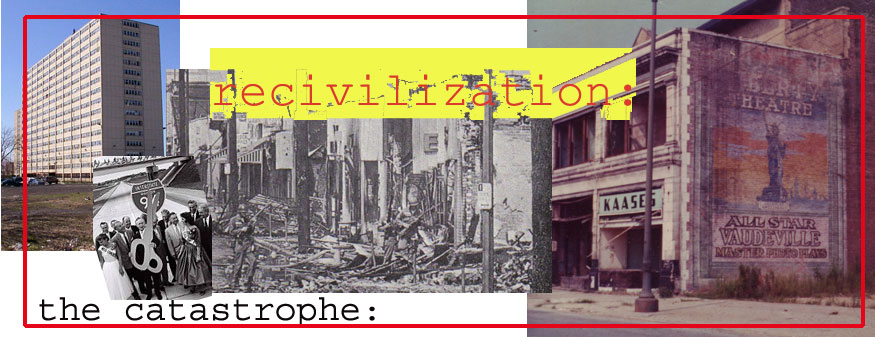

318 blockbustersWith the huge numbers of blacks coming into cities in the 50's, containment could not have been maintained forever. Both the residents of white areas bordering the ghetto and the politicians who supported them realized that all their antics were only a holding action. In the 20's change had gone block by block; now it was neighborhood by neighborhood. As changeovers increased, profiteering from them became big business. Blockbusting—manipulating a neighborhood to scare whites out—was first noticed in 1890's Harlem, where its practitioners were called 'white blackmailers'. Though hardly ever discussed, it was common in many cities in the 20's, notably Chicago. By the 50's and 60's, it has been estimated that Chicago had over 100 blockbusting realtors. These were the shock troops-the more respectable downtown firms would watch the situation closely, then move in as soon as the panic started. Bolder scalawags downtown would set up a number of dummy companies to hide their involvement, or use black realtors as fronts, and claim up to one third of the realtors' fee from them as 'referrals'. Some blockbusters were land speculators, or 'evacuators' as they were called, usually bottom feeders dealing in marginal land who found opportunities for big profits in buying buildings and installing black tenants to start the process. Huge profits could be made, buying cheap and selling dear, and the opportunity attracted shady operators from all over. A few blacks, the ones selected for blockbusting, got good bargains if they could stand the strain. The rest paid high prices, because property values always rise at the beginning of a period of racial transition, and many of them were simply ripped off. Collusions between blockbusters and savings and loans were common-setting families up with debt burdens they could not possibly handle, and then foreclosing to recycle the property for the same scam over again. The big downtown realtor that blockbusted Baltimore's Edmondson Village area in the 50's offered the handsome sum of $15,000 for the first houses on a block, and sold them cheap to blacks; after the panic started the firm could buy as many homes as it liked more cheaply, and get good prices for them. A panic was the most profitable outcome for the realtors and speculators. Panics began with a very unhealthy period in which neighbors watched each other very closely, to try and guess who was sticking and who was selling out. The circling sharks found new tactics to turn up the heat: spreading rumors, stirring up street trouble, or simply paying black men to walk down white streets. If they succeeded, whites would evacuate en masse. For them, it wasn't just fear of black faces; the real panic was losing one's biggest investment, one's home. Throughout the neighborhood integration fights of the 50's, white activists told the press that they were mainly worried about their property values; it may be some small consolation to blacks to know that most of them were sincere. Evil had become so easy and profitable that it corrupted an entire profession. Realtors and their trade organizations always fought proposed anti-blockbusting measures, and they remained totally uninterested in policing themselves. A strong city might have simply banned all realtors from seeking business in a sensitive area. America's weak cities, in a time when any regulation of the business seemed unthinkable, were reduced to trivial defenses such as bans on yard signs, and even on the few occasions when these were passed, the courts often threw them out. The maintenance of segregation was carefully managed by cities' elites. In Boston in the 60's, banks did a thriving business in low-interest government-insured mortgages to blacks, but they maintained a tacit agreement among themselves to manage where blacks could live by pushing them into Mattapan; in effect, the banks engineered the massive population change that turned Mattapan from a modest but stable, integrated working class neighborhood into an extension of the Roxbury ghetto. Academics noted decades ago that in urban settlement patterns, blacks tend to follow Jews. It wasn't because they liked each others' company; in Boston and no doubt most other big cities, this singularity was the result of a tacit agreement on the part of financiers, real estate men and politicians. Jews and blacks were both undesirable to the elites, and they protected their own neighborhoods at the Jews' expense. The blockbusters who concentrated on Jewish neighborhoods were simply taking the line of least resistance. Give a thought for the average white Americans who were panicked out of their neighborhoods. Refugee status was the price whites often paid for institutionalized racism, the refusal of the community as a whole to even consider liberty of residence as an option. Times were good, and most families landed on their feet in a suburban bungalow with all the amenities and a spacious yard. Still, it didn't always work out. A world was lost, a dense network of human connections and neighborhood institutions. The old neighborhood was a tragedy one preferred not to discuss; the new one seemed so artificial in comparison. Give a thought for the average black Americans who thought they had found the ticket to advancement, but instead watched as disinvestment sucked all the capital out of their neighborhoods, while demoralized and financially distressed city governments lost all interest in their public services, their schools and their safety. Community organization seemed a bright hope in a hopeless time, but its failure to maintain integrated neighborhoods in the 60's and 70's was total. Some of the cleverest organizers, as in Saul Alinsky's Woodlawn Organization, were reduced to what they called 'Potemkin village' tours of modest successes for visitors from the media, the foundations and the government. In Woodlawn, a mighty and determined effort was foiled by street crime, gangs like the Blackstone Rangers, rotten schools and the continual drain of upwardly-mobile people. The same sad story dragged on for years wherever a strong community organization fought against the tide. Groups such as Cleveland's Buckeye-Woodland Community Congress, frequently written up as a national model in the 70's, worked tirelessly to build community and maintain an integrated neighborhood; Buckeye-Woodland's bright and dedicated people, black and white, held their parades and rallies and bake sales and clean-up campaigns, and their hearts broke one by one as the last white folks in the neighborhood trickled away, with no new ones coming in to replace them. Eventually they would move out too. That celebrated concept, 'benign neglect', wasn't invented by Pat Moynihan and Richard Nixon. In the face of a growing crisis, city officials dealt with the new, expanded ghetto in exactly the same way they had done the old one. When they could not get Uncle Sam's help to eliminate a black neighborhood, they simply ignored it. Sometimes, important parts of history fall through the cracks; doing nothing leaves few traces. In every city, administrations deprived black neighborhoods of city services, and for all the liberal good intentions and lip-service of the 50's and 60's, this did not change. Crime, vice and disorder were tolerated by the police and the white community, as long as they could be kept 'black'. This contributed greatly to the deterioration of the quality of life in the new black neighborhoods, and also gave rise to irresistible opportunities for corruption on the part of city officials. When a neighborhood went black, housing and building inspectors were seldom seen again. The anecdotal evidence does not fully answer how much of this was simple prejudice—'that's the only way they know how to live'—and how much corrupt arrangements between inspectors and landlords. Despite low income and lack of access to loans for improvement, black homeowners generally maintained their new properties with pride. Outside the few high-density, tenement superslums such as Harlem, the average black inner-city neighborhood took on the form still visible today: streets of homes not too much different from those of their white-owned counterparts, off main streets lined with apartments and mixed retail-residential buildings generally shot to hell. From the black's point of view, it seemed as if the white man, his city and his government had not missed a single trick in finding ways to make him miserable. In housing, like groceries and everything else, blacks always paid top dollar. Even homeownership, the ticket to advancement for everyone else, wasn't a good bet for them. While whites built equity, disinvestment assured that the value of ghetto real estate grew much more slowly than anything else. Studies perversely suggest that most blacks would have been better off renting, and investing their down payment in stocks. |
|

|